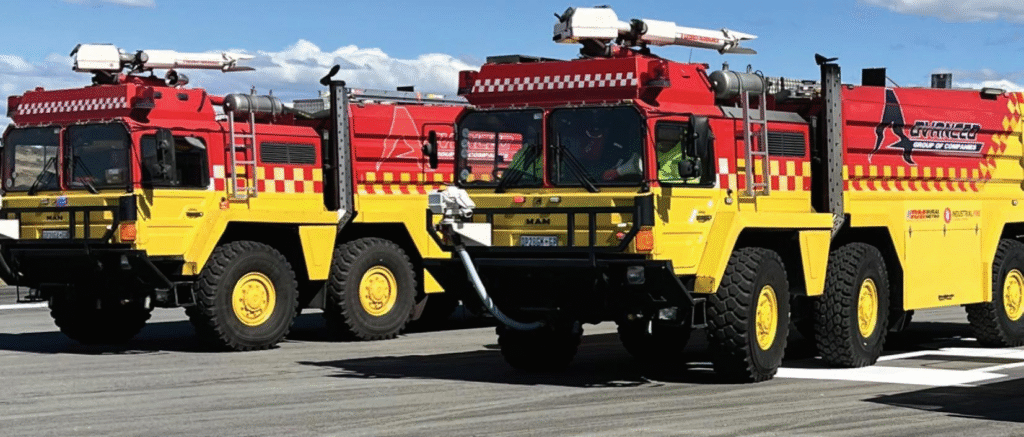
Introduction
Fire and rescue services are a critical component of aviation safety, especially at airports where rapid response can mean the difference between life and death during emergencies. In East Africa, the aviation sector’s growth—driven by increasing passenger numbers, new airports, and expanding regional connectivity—has put pressure on Airport Rescue and Fire Fighting Services (ARFFS) to meet evolving safety demands. However, many airports in the region face challenges ranging from outdated equipment and insufficient training to limited compliance with ICAO standards. This article examines the status of ARFFS across East Africa, the initiatives underway to modernize these services, and what more needs to be done to ensure timely and effective emergency response capabilities at the region’s airports.
Why ARFFS Matter
Airport fire services must be prepared for a wide range of scenarios: aircraft fires, fuel spills, runway excursions, cargo fires, and building fires. ICAO Annex 14 mandates that airports have dedicated ARFFS based on aircraft traffic and operational risk. These units must be capable of responding within 2-3 minutes to the midpoint of any runway, using specialized firefighting vehicles and trained personnel.
In East Africa, as aviation traffic increases and new airlines emerge, the burden on emergency response systems is growing. Ensuring effective ARFFS is not just about compliance—it’s about saving lives and safeguarding airport operations.
Current State of ARFFS in East Africa
- Equipment Deficiencies
Many regional airports—especially secondary and domestic facilities—still rely on outdated or insufficient firefighting vehicles and gear. Some operate with aging foam tenders, limited water supplies, and inconsistent maintenance schedules. This hinders their ability to respond effectively to complex or large-scale emergencies.
For instance:
- Smaller airstrips in South Sudan and Somalia often lack specialized fire units altogether.
- Secondary airports in Tanzania and Uganda operate with limited fire categories due to lack of advanced ARFFS equipment.
- Training Gaps
Fire and rescue personnel at East African airports often receive irregular or outdated training. While international airports like Jomo Kenyatta International (Kenya) or Bole International (Ethiopia) may have training partnerships or simulator access, smaller facilities often lack structured refresher programs or ICAO-aligned training syllabi.
Furthermore, retention of qualified fire officers is a problem, as low pay and limited career development opportunities lead to high turnover.
- Compliance Disparities
Only a handful of major airports in East Africa consistently meet ICAO-recommended fire and rescue standards. This results in mismatched safety levels across the region, particularly problematic for international operators and insurance providers assessing risk.
Airports like Kigali International (Rwanda) and Entebbe International (Uganda) have improved their ARFFS categorization in recent years, but others remain below the recommended levels.
- Funding and Prioritization Issues
Many national civil aviation authorities face tight budgets and tend to prioritize air navigation, runway resurfacing, or terminal expansion over ARFFS investment. As a result, modernization of fire and rescue infrastructure is often delayed or excluded from strategic plans.
Efforts Toward Modernization
- Fleet Upgrades and Equipment Donations
Some countries are receiving support from ICAO, African Development Bank, and bilateral partners for ARFFS upgrades:
- Kenya Airports Authority has procured new Rosenbauer Panther fire trucks for key airports since 2021.
- Rwanda Civil Aviation Authority received international aid to refurbish firefighting vehicles at Kigali International.
- Tanzania and Ethiopia have also invested in foam tenders and rapid intervention vehicles for their busiest hubs.
These upgrades improve water capacity, foam dispersion systems, and reliability in extreme conditions.
- Establishment of ARFFS Training Centers
Training is a major focus for long-term improvement:
- Kenya operates a regional aviation fire training center in Embakasi, Nairobi, that serves both local and international trainees.
- Ethiopia Aviation Academy has added emergency response modules to its training syllabus.
- ICAO’s East African regional office in Nairobi supports workshops and table-top exercises for ARFFS development.
There’s a growing push to introduce virtual simulation and live fire training environments to accelerate skill development.
- Standardization Through CASSOA
The East African Community Civil Aviation Safety and Security Oversight Agency (CASSOA) is working to harmonize minimum ARFFS standards across member states. This includes categorization guidelines, response time benchmarks, and equipment checklists.
Such efforts are essential to ensure interoperability, especially in emergency scenarios that may require mutual support across borders.
- Integration With Airport Emergency Plans
Airports in Uganda, Kenya, Rwanda, and Tanzania have been updating their Airport Emergency Plans (AEPs) to clarify the role of fire services during multi-hazard events such as terrorist attacks, runway collisions, or fuel depot fires. Integrated emergency drills involving fire, police, medical, and air traffic staff are becoming more frequent.
These efforts promote collaboration and ensure coordinated crisis response.
Recommendations for Further Improvement
- Invest in ARFFS Equipment for Secondary Airports
While international hubs receive attention, domestic and regional airports must also be equipped to handle emergencies. National governments should allocate targeted funding for ARFFS fleet expansion beyond capital cities.
- Regional ARFFS Training Accreditation
East Africa would benefit from a shared training and certification framework for fire personnel. This would reduce duplication, lower training costs, and create a regional pool of deployable ARFFS experts.
- Improve Career Pathways for Fire Officers
Offering incentives such as career advancement, regular promotions, and allowances for hazardous duty could improve retention and professionalism among ARFFS staff.
- Conduct Regular Evaluations and Drills
Annual inspections, third-party audits, and full-scale emergency drills should be institutionalized to keep ARFFS units ready. Regional competitions and exercises can promote skill-sharing and healthy benchmarking.
Conclusion
Robust fire and rescue capabilities are essential for safe and resilient airport operations. While East Africa has made progress in modernizing its ARFFS—particularly at major airports—more investment and coordination are required to ensure that all aviation facilities, large and small, are adequately prepared for emergencies. With improved equipment, training, regional harmonization, and strategic prioritization, the region can raise the bar for airport emergency readiness and protect the growing number of passengers using its airspace.


